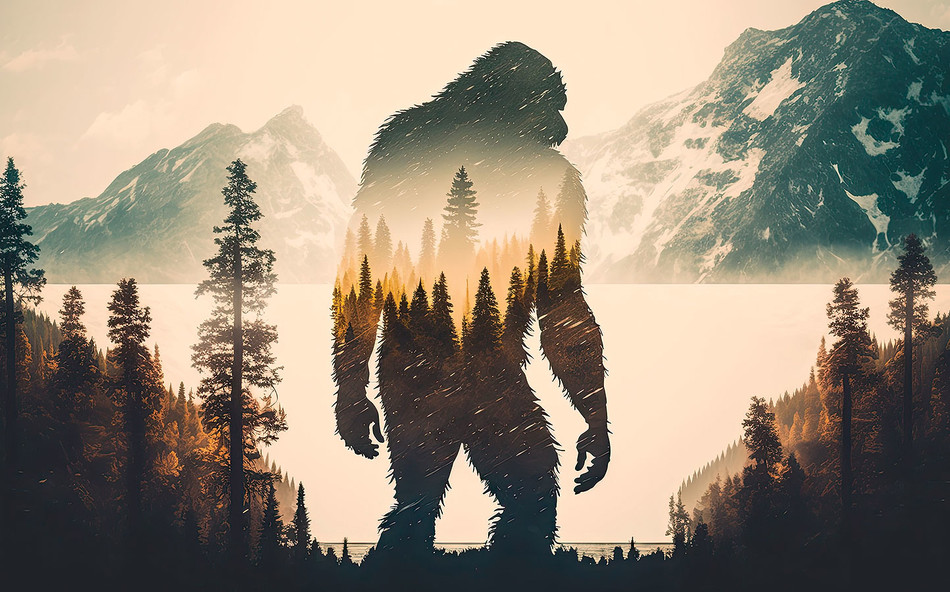In The Secret History of Bigfoot, journalist John O’Connor ’03SOA explores the mystery and legacy of the North American sasquatch.
What exactly is Bigfoot?
It depends on who you ask. There are two realms of thinking. Folks who call themselves “flesh-and-blooders” believe that Bigfoot is an undiscovered giant hominid that has somehow escaped detection in the American wilds. Those often described as “woo-ers” believe that Bigfoot is magical or paranormal and can disappear through wormholes. There’s a lot of gray area and overlap between those two beliefs.
Where did the myth originate?
Bigfoot is a strangely cross-cultural and trans-historical figure. Some of the oldest American Indigenous legends deal with Bigfoot-like creatures. There are similar mythical monsters found throughout most of the world, including Australia, South America, and Japan. There were “wild men” in medieval European folklore. The most recent American iteration of Bigfoot comes from Northern California in the late 1950s, after a logging crew claimed to find large hominid tracks in an area called Bluff Creek. The famously disputed 1967 Patterson-Gimlin film, which shows a grainy Bigfoot striding across a riverbed in harsh sunlight, was shot there. I would argue that the iconic image of Bigfoot you see on beer cans and bumper stickers comes from this film.
How did you conduct field research on the creature?
The project started years ago as an admittedly bad screenplay I wrote with a friend who, like me, was an underemployed stay-at-home dad. We shelved the script, but I later came back to the topic. As part of my research, I attended Bigfoot conventions and went on four “expeditions,” two of them organized by the Bigfoot Field Researchers Organization, where you camp out in the woods looking and listening for evidence of Bigfoot. I also did my own self-guided expedition in the North Cascades in Washington. I didn’t find Bigfoot.
Numerous alleged Bigfoot sightings are reported each year. What explains this phenomenon?
I think the sightings boil down to misperception, what psychologists call the predictive brain and our desire to see what we want to see. Our minds are very good at convincing us that what we want to be there is there. Bigfooters certainly aren’t alone in harboring irrational beliefs.
The prevalence has a lot to do with what’s on TV and the Internet. When the Animal Planet reality series Finding Bigfoot aired, from 2011 to 2018, there was a huge uptick in Bigfoot sightings. Similarly, the most popular years of The X-Files saw a 200 percent increase in UFO sightings. Hoaxes also play a role: there are people who go out in the woods and take staged photos or videos and post them online.
Do you see an overlap between Bigfoot believers and other types of conspiracy theorists?
In most cases, Bigfooting is a benign weekend activity for people who are maybe yearning for something they can’t quite articulate. The majority tend to be white, male, conservative, and working- or middle-class. But lots of research has shown strong connections between supernatural beliefs and conspiracy thinking, and at the margins of Bigfoot culture are folks like right-wing Second Amendment fanatics and what I would call January 6 types.
Is there any convincing evidence for Bigfoot?
In terms of physical evidence, there isn’t much — no credible photographs or videos, certainly no fossil evidence, and no DNA analysis of hair or scat. Footprints thought to be from Bigfoot tend to have clear alternative explanations; often they’re bear tracks. Bigfoot believers like to argue that no remains have been found because large mammal bones decompose very quickly in the wild. I’ve talked to wildlife experts from Maine to Montana, and they’ve all told me that’s utter bullshit, that old bear and moose bones are found in remote locations all the time.
I think that, especially now, we need to be governed by reason and fact-based reality, and Bigfoot simply defies logic. We’re not talking about a tiny salamander. The idea that a seven-hundred-pound mammal could survive in the United States without being noticed or monitored is just inconceivable.



